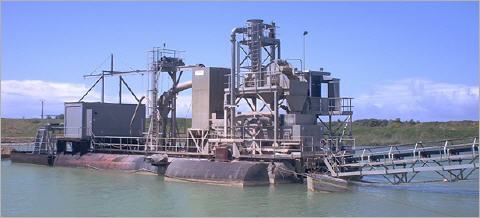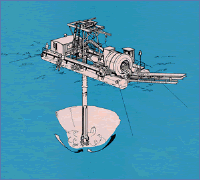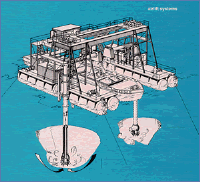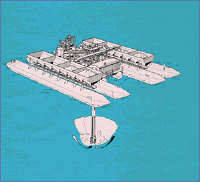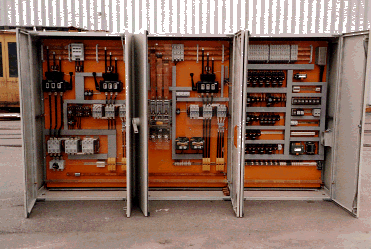Pressair International
Pressair dredges are committed to excavating masses of solids such as sand, gravel, and ore. They are the backbone of any processing facility and must perform efficiently and trouble-free over many years or even decades. Efficient energy usage, high solids output, little wear, 100% availability and complete, clean excavation of the deposit are standard features that a Pressair dredge offers.
The time has come for Pressair.
- Pressair supplies the dredge that meets your expectations:
- solids production 300 – 700 t/h independent of dredging depth
- continuous production (no empty cycles)
- high solids concentration (twice as much solids as a suction dredge)
- handles oversize up to 350 mm diameter
- dredging depth 15 – 100 m under water with constant output
- complete excavation of deposit, no losses
- applicable under adverse conditions (compacted soil, hard layers, clay....)
- efficient energy usage
- little wear ("all-in" service contract available)
- ecologically friendly (Eco-Cert)
- little maintenance
- easy to operate, fully automated system available
- 1/3 lower investment cost compared with a grab dredge
- clean, vigorously washed aggregate (better quality material, lower processing costs)
Not "off the shelf"
but as reliable as a machine built in series. Pressair dredges are tailored to the job. Proven components of most reputable suppliers and task-optimized engineering guarantee a reliable service.
As requested, diesel powered or electrical, with dewatering drum, wheel, screen or for direct discharge into barges – all options are possible
High performance as a standard:
Pressair dredge model series:
| depth / ft |
DSB 300 t/h |
kw | DSB 400 | kw |
DSB 450 t/h |
kw |
DSB 400-2 t/h |
kw |
| 20 / 65 | 270 | 150 | 360 | 180 | 400 | 230 | 700 | 360 |
| 30 / 98 | 300 | 200 | 400 | 230 | 430 | 280 | 720 | 460 |
| 40 / 131 | 315 | 250 | 405 | 275 | 440 | 330 | 730 | 550 |
| 50 / 164 | 320 | 300 | 410 | 325 | 450 | 350 | 735 | 650 |
Values for orientation only and at normal deposit.
Data of other models/ depth on demand.
When is a Pressair the right choice?
There exists no universal machine that is equally well suited for any deposit, granulation and depth. Generally we recommend Pressair dredges when the possible depth exceeds 15 m and where it is not pure sand. However, there are other aspects to consider, such as transport distance, foreign particles and oversize material, and the expected total lifetime of a deposit. You can trust our expertise and that we will consider your project impartially and, if after consideration decide that our own system is not suitable, recommend a conventional technology.
Unlike other traditional dredging methods, in a Pressair dredge there are no mechanical parts directly attacked by abrasive or destroying particles. Solids do not have to pass pump shells, impellers or ellbows. There are no wearing buckets, rods, pins, chains or ropes, and thanks to the vertical position of the dredging pipe, hardly any wear occurs there. The result is lower maintenance and wear costs, and unmatched reliability and productivity.
For more information about Pressair's principle of operation, select technology.
Browse through our picture gallery where we show some typical Pressair dredges and pertinent equipment.
The following pictures show the solids production after separation of water by means of a Pressair drum, screen, wheel or direct discharge into barge. To transport material (in particular sand and silt) hydraulically over long distances, we can offer booster stations for pipeline transport.
The following pictures show the solids production after separation of water by means of a Pressair drum, screen, wheel or direct discharge into barge. To transport material (in particular sand and silt) hydraulically over long distances, we can offer booster stations for pipeline transport.
What counts:
- constant excavation
- from any depth
- most economically !
| Dewatering drum | |
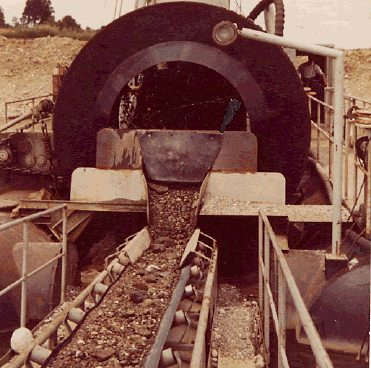
|
The most economical way to separate solids from water. Also available as a 2-stage drum to handle higher sand concentrations and as a classifier to remove sand, silt or coal Detais? - click here |
| Dewatering screen | |
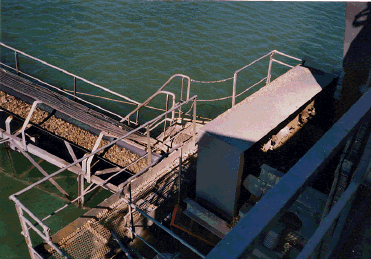
|
Horizontal 2-deck dewatering screen. Recommended for coarse or soiled material, optional with fine sand treatment plant (pump and cyclone). |
| Dewatering wheel | |
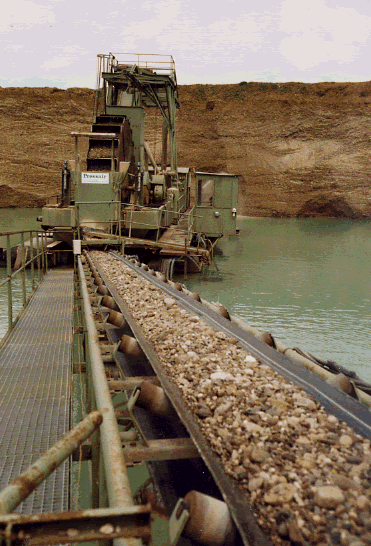
|
Preferably for aggregate with high sand concentration. Major features of the wheel are its efficiency in sand dewatering, its low energy consumption, little wear and low noise level. However, investment costs exceed those of a drum or screen. A double wheel with extended settling tank and transportation screw blades can handle sand concentrations of 100%. |
| Direct discharge | |
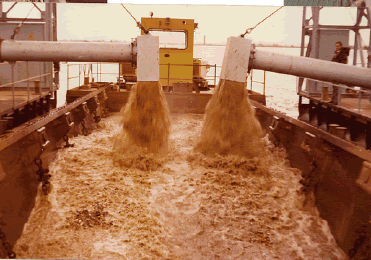
|
Thanks to the high solids concentration delivered by Pressair dredges, direct discharge into barges is possible without the disadvantage of too much overweir. |
| Complete | |
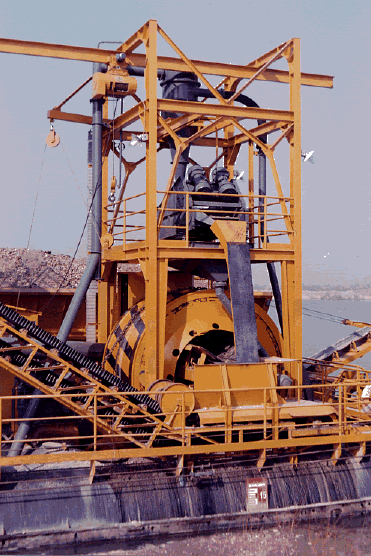
|
This picture shows an example of a complete and complex on-board Pressair-dewatering plant. Because of long transport distances, Pressair-Monting supplied this dredge completely with self-discharging silo barges. The dredge fills the barges whilst these lay alongside, and then the barges are moved to the discharge point where they empty themselves by means of conveyors. The whole plant is controlled by just one operator, bringing 360 t/h ashore. An impression of the efficiency of this dewatering system consisting of drum, sand pump, cyclone and dewatering screen gives the steep rising conveyor and the barge in the background whose hopper is piled up. |
For material transportation Pressair can supply self-propelled bottom-dump-barges, self-discharging silo-barges and floating conveyors. Floating conveyors are available as 20 m units and as modular catamaran-type units with up to 100 m length.
The following pictures show some Pressair installations around the world, serving our customers to maintain a reliable and economical production and to generate the best return on their investment.
The 2 machines below are DSB 400's with dewatering screens and fine sand processing plants. They produce 400 t/h at 20 resp. 30 m depth.
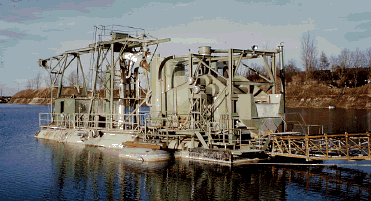
|
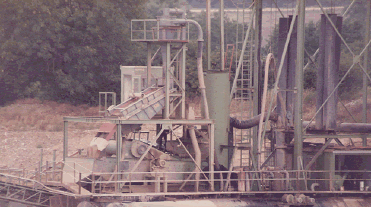
|
The dredge below is a DSB 300 with dewatering wheel. It works – as can be seen by the vertical gravel face – in very compacted gravel and delivers 350 t/h at 18 – 20 m depth. Dewatering wheels are a good solution where sand is dominant. To cope with sand only or high contents of fines, Pressair can offer twin wheels with an enlarged settling tank.
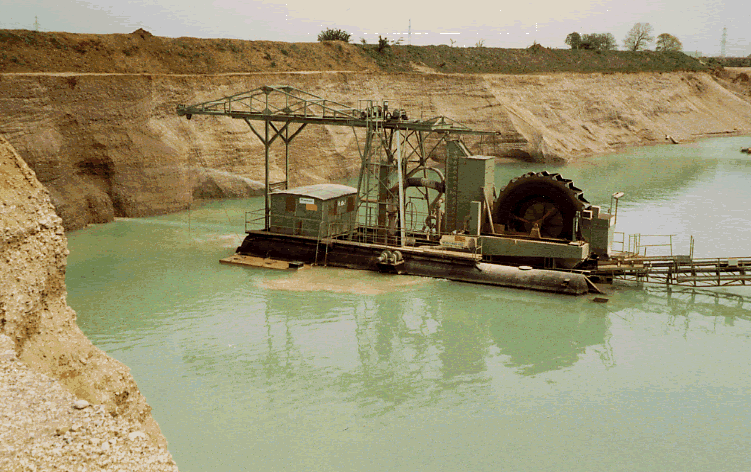
|
Below is an engine powered DSB 400-2 twin dredge working in a large drinking water reservoir.
Twin dredges have 2 dredge pipes and can produce up to 700 t/h. Because of the large transport distance, the dredge discharges directly into 200 m³ self-propelled Pressair bottom-dump barges. For loading, the barges enter between the catamaran-type pontoon. As visible, the solids/water ratio is important with a minor overweir of sand. This dredge meets rigid standards concerning environmental and safety aspects.
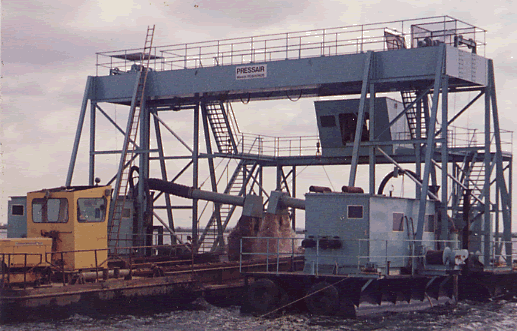
|
| Compressor | |
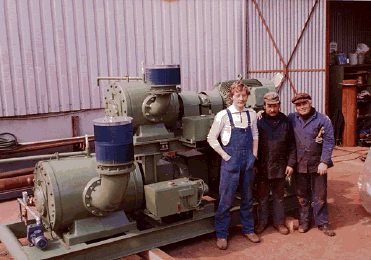
|
Other applications for our compressors: - deep-sea aeration - foundry and oil industry - ice-prevention on floodgates, harbours etc. |
Delivery head
|
Shipment of a Pressair delivery head 15 kW, 2,5 t, operating depth – 100 m (330 ft) |
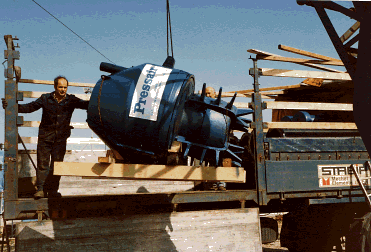
|
Custom-designed delivery heads available for many applications in - dredging - offshore operations - civil engineering - maintenance Send your inquiry with project details ! |
Industrial automation
Full control
Below is a view on a typical Pressair control panel in the operators cabin. All functions are visualized on the touch screen display. In automation mode, there is just one button to push and the machine runs by itself. The major operating conditions such as output capacity, dredging depth, pressure etc. are displayed. In case of a failure, the machine automatically reacts.
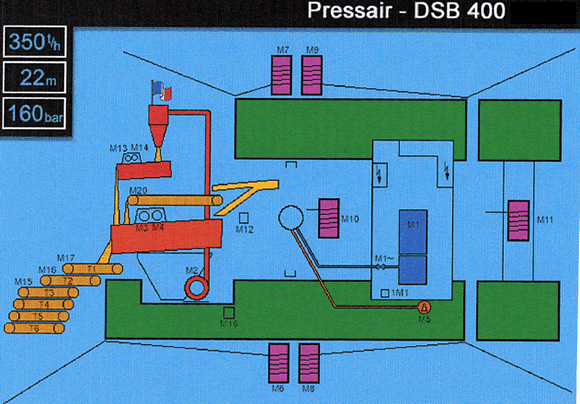
|
Typical Pressair visual-touch-screen start display. All controls are clearly arranged over several pages. The major operating data such as output capacity, dredging depth, operating hours etc. are shown.
Maintenance & Service
A Pressair does not require frequent maintenance. Compressor and motors are maintenance free and are continuously electronically surveyed. Wear sensors in the delivery head automatically signalize when set tolerances are touched. The service check interval is once a year respective every 1.600 operating hours
